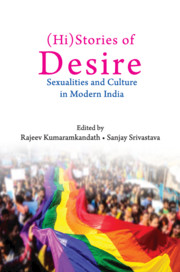Book contents
- Frontmatter
- Contents
- List of Images
- Acknowledgements
- Introduction: Sexuality and Sexualities
- 1 Politics of Prop Roots: Beyond ‘The Repressive Hypothesis’
- 2 Of Identities and Other Desires: Thinking about Sexualities
- 3 The Stuttered Process of Subject Formation: A Sex Worker's Experiments with Narration
- 4 Sexual Realism? (Hetero)Sexual Excess and the Birth of Obscenity in Malayalam Literature
- 5 Sexualizing Kālā Pāni
- 6 Memories of a Queer Sexuality: Revisiting Two ‘Toto’ Folk Tales
- 7 Learning about Sex in Mumbai: Rethinking the ‘Knowledge Gap’ Debate in Sexuality Education
- 8 Family Planning and the Masculinity of Nirodh Condoms in India
- 9 Women and Their Bodies: Menstrual Celebrations and Construction of Sexuality in Assam
- 10 Tanjai Prakash: Between Desire and Labour
- 11 Hijra Intimacies and Inheritances
- Notes on Editors and Contributors
- Index
8 - Family Planning and the Masculinity of Nirodh Condoms in India
Published online by Cambridge University Press: 24 December 2019
- Frontmatter
- Contents
- List of Images
- Acknowledgements
- Introduction: Sexuality and Sexualities
- 1 Politics of Prop Roots: Beyond ‘The Repressive Hypothesis’
- 2 Of Identities and Other Desires: Thinking about Sexualities
- 3 The Stuttered Process of Subject Formation: A Sex Worker's Experiments with Narration
- 4 Sexual Realism? (Hetero)Sexual Excess and the Birth of Obscenity in Malayalam Literature
- 5 Sexualizing Kālā Pāni
- 6 Memories of a Queer Sexuality: Revisiting Two ‘Toto’ Folk Tales
- 7 Learning about Sex in Mumbai: Rethinking the ‘Knowledge Gap’ Debate in Sexuality Education
- 8 Family Planning and the Masculinity of Nirodh Condoms in India
- 9 Women and Their Bodies: Menstrual Celebrations and Construction of Sexuality in Assam
- 10 Tanjai Prakash: Between Desire and Labour
- 11 Hijra Intimacies and Inheritances
- Notes on Editors and Contributors
- Index
Summary
Introduction
Till the mid-twentieth century, advertisements of potency pills made up a substantial part of the corpus of bazaar drugs. Advertisements of potency pills fed into a machismo image and nurtured an anxiety around the loss of semen; masculinity was equated with fertility and loss of semen implied an alleged loss of masculinity. Advertisements of potency pills, thus, promoted masculinity only in terms of physical strength and in terms of proper allocation and f low of vital fluids. With the launch of the Family Planning Programme in 1952, there was a clear transition in the domain of advertisements – advertisements selling potency pills were not only considerably reduced but the air of secrecy which previously hung around advertisements of contraceptives (condoms, pessaries, and diaphragms) were also lifted. More importantly, masculinity was no more articulated only in terms of physical aspects such as strength, fertility, and the f low of body f luids; a new brand of masculinity was endorsed through family planning advertisements, which upheld birth control as an economic necessity and a social obligation. Family planning advertisements thereafter altogether disregarded birth control as a corporeal issue. Family planning endorsed a new kind of masculinity which was foregrounded in a language of socio-economic development. It relentlessly portrayed an image of scarcity and poverty, and projected the idea of an imminent and imaginary doom if family planning is not practised. By the second half of the 1950s, family planning not only overshadowed all other aspects of reproductive health but also proliferated into aspects of economic policy. This chapter explores the domain of family planning advertisements to interrogate into the nature of masculinity that was generated around the use of Nirodh condoms to understand whether there was a shift in the nature of ‘hegemonic masculinity’ around men's participation in contraception. It explores how and in what ways a new masculinity was created around the participation of men in contraception, in arguing that this new masculinity that was nurtured through advertisements of Nirodh condoms led to a re-masculinization that was articulated primarily in an economic idiom rather than corporeal. This chapter, therefore, begins by pointing out how sexual hierarchies based on age produce different brands of masculinity and are often organized differently.
- Type
- Chapter
- Information
- (Hi)Stories of DesireSexualities and Culture in Modern India, pp. 134 - 151Publisher: Cambridge University PressPrint publication year: 2020
- 1
- Cited by



